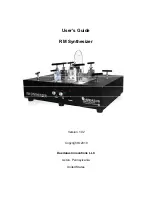
V
oice mode
P
erf
ormance
mode
Multi mode
Utility mode
File mode
Master mode
Multi V
oice
mode
Sequence Pla
y
mode
Ref
erence
Voice Edit mode
Normal Voice Edit Element Edit
134
Owner’s Manual
[SF3] LIMIT
NoteLimit
Determines the lowest and highest notes of the keyboard range for each Element. The selected Element will
sound only when you play notes within this range.
Settings:
C -2 ~ G8
n
You can also create a lower and an upper range for the Element, with a note range “hole” in the middle, by specifying
the highest note first. For example, setting a Note Limit of “C5 - C4” lets you play the Element from two separate ranges:
C -2 to C4 and C5 to G8. Notes played between C4 and C5 do not play the selected Element.
n
You can also set the range directly from the keyboard, by holding down the [INFORMATION] button and pressing the
desired low and high keys.
VelocityLimit
Determines the minimum and maximum values of the velocity range within which each Element will respond.
Each Element will only sound for notes played within its specified velocity range. For example, this lets you
have one Element sound when you play softly and have a different one sound when you play strongly.
Settings:
1 ~127
n
You can also create separate low and high ranges for the Element, with a velocity “hole” in the middle, by specifying the
maximum value first. For example, setting a Velocity Limit of 93 - 34 lets you play the Element from two separate velocity
ranges: soft (1 - 34) and hard (93 - 127). Notes played at middle velocities between 35 and 92 do not play the selected
Element.
VelCrossFade
(Velocity Cross Fade)
This determines how gradually the sound of an Element decreases in volume in proportion to the distance of
velocity changes outside the Velocity Limit setting (above). The practical application of this parameter is to
create natural-sounding velocity crossfades, in which different Elements change gradually depending on how
strongly or softly you play. The higher the value, the more gradual the level change.
Settings:
0 ~ 127
[F2] PITCH
[SF1] TUNE
From this display you can set various pitch-related parameters for the selected Element.
Coarse
Determines the pitch of each Element in semitones.
Settings:
-48 ~ 0 ~ +48
Fine
Determines the fine tuning for the pitch of each Element.
Settings:
-64 ~ 0 ~ +63
FineScaling
Determines the degree to which the notes (specifically, their position or octave range) affect the pitch in fine
tuning (set above) of the selected Element, regarding C3 as the basic pitch.
A positive setting will cause the pitch of lower notes to change lower and that of higher notes to change higher.
Negative values will have the opposite effect.
Settings:
-64 ~ 0 ~+63
Random
This lets you randomly vary the pitch of the Element for each note you play. This is effective in reproducing the
natural pitch variations in acoustic instruments. It is also useful for creating unusual random pitch changes. The
higher the value, the greater the pitch variation. A value of “0” results in no pitch change.
Settings:
0 ~127
[SF2] VEL SENS
(Velocity Sensitivity)
From this display you can determine how the Pitch EG responds to velocity.
EGTime,
Segment
Determines the velocity sensitivity of the PEG’s Time parameters. Select the Segment first, then set its Time
parameter. Positive Time settings will play back the specified Segment faster in proportion to the played
velocity and negative values will play it back slower.
Settings:
EGTime: -64 ~0 ~+63
Settings:
Segment: atk, atk+dcy, dcy, atk+rls, all
atk (attack) .............................EG Time Value affects Attack time.
atk+dcy ( decay) ......EG Time Value affects Attack/Decay1 time.
dcy (decay)............................EG Time Value affects Decay time.
atk+rls ( release).......EG Time Value affects Attack/Release time.
all ..........................................EG Time Value affects all PEG Time parameters.
EGDepth,
Curve
Determines the velocity sensitivity of the PEG Level. Positive settings will cause the pitch change to rise the
harder you play the keyboard, and negative values will cause it to fall. The Curve parameter lets you select
from five different preset velocity curves (graphically indicated in the display), that determine how velocity
affects the Pitch EG Depth.
Settings:
EGDepth: -64 ~ 0 ~ +63
Settings:
Curve: 0 ~ 4
Pitch
Determines the velocity sensitivity of the Pitch. Extreme values produce greater variation in PEG Depth. For
positive values, the harder you play the keys, the greater the change in PEG Depth. For negative values, the
softer you play the keys, the greater the change in PEG Depth.
Settings:
-64 ~ 0 ~ +63
[SF3] PEG
(Pitch Envelope Generator)
From this display you can make all the time and level settings for the Pitch EG, which determine how the pitch
of the sound changes over time. These can be used to control the change in pitch from the moment a note is
pressed on the keyboard to the moment the sound stops.
The full names of the available parameters are shown in the chart below, as they appear in the display.
Settings:
TIME: 0 ~ 127
LEVEL: -128 ~ 0 ~ +127
DEPTH: -64 ~ 0 ~ +63
n
For details on the PEG, see page 112.
HOLD
ATK
DCY1
DCY2
REL
DEPTH
TIME
Hold time
Attack time
Decay1 time
Decay2 time
Release time
LEVEL
Hold level
Attack level
Decay1 level
Decay2 level
Release level
Depth






































